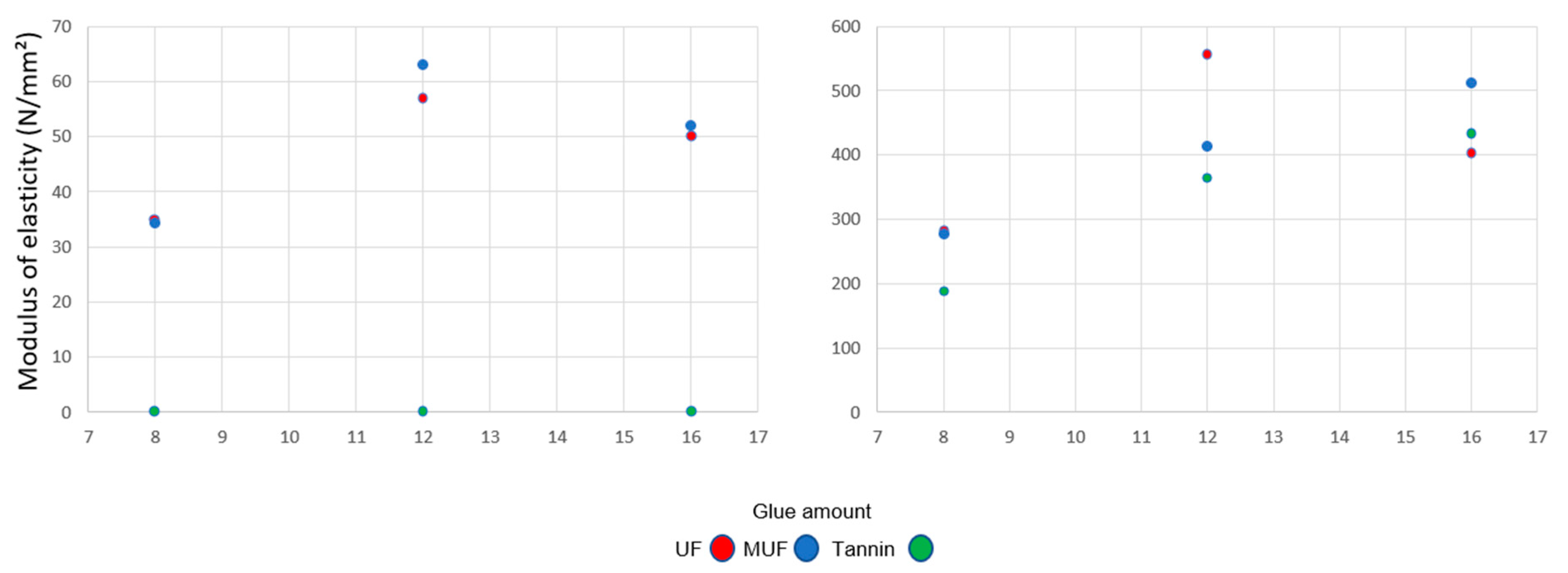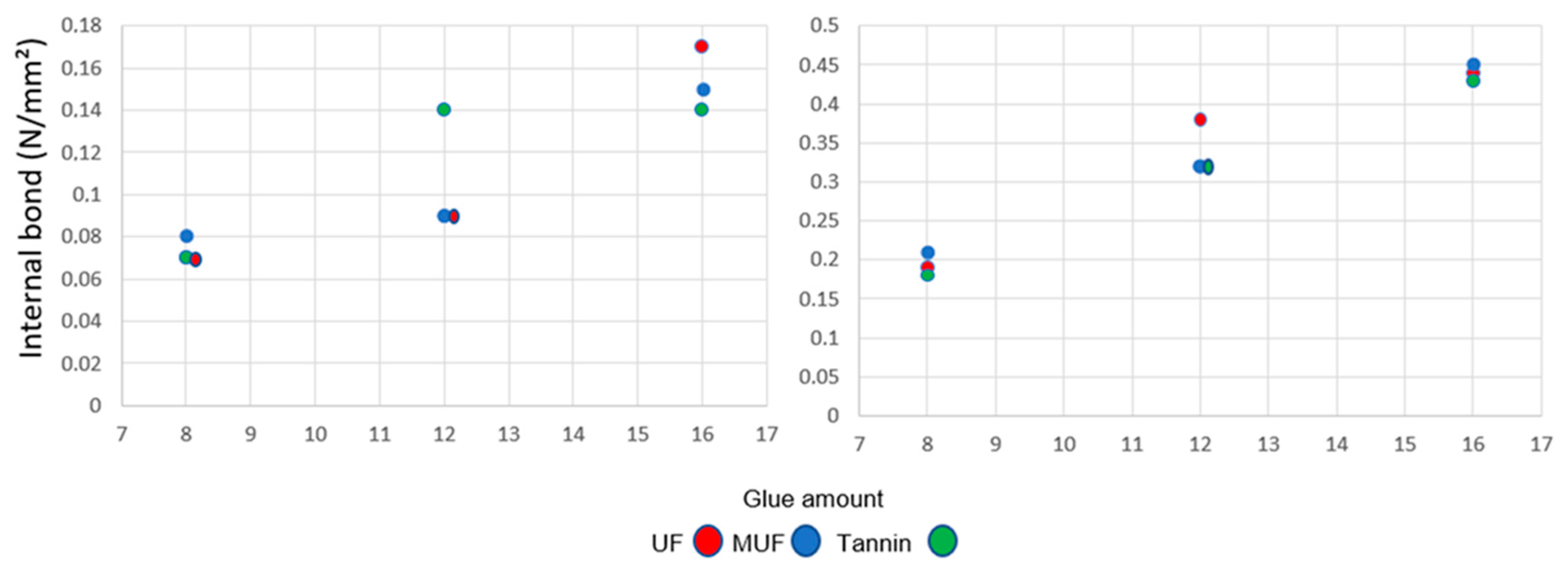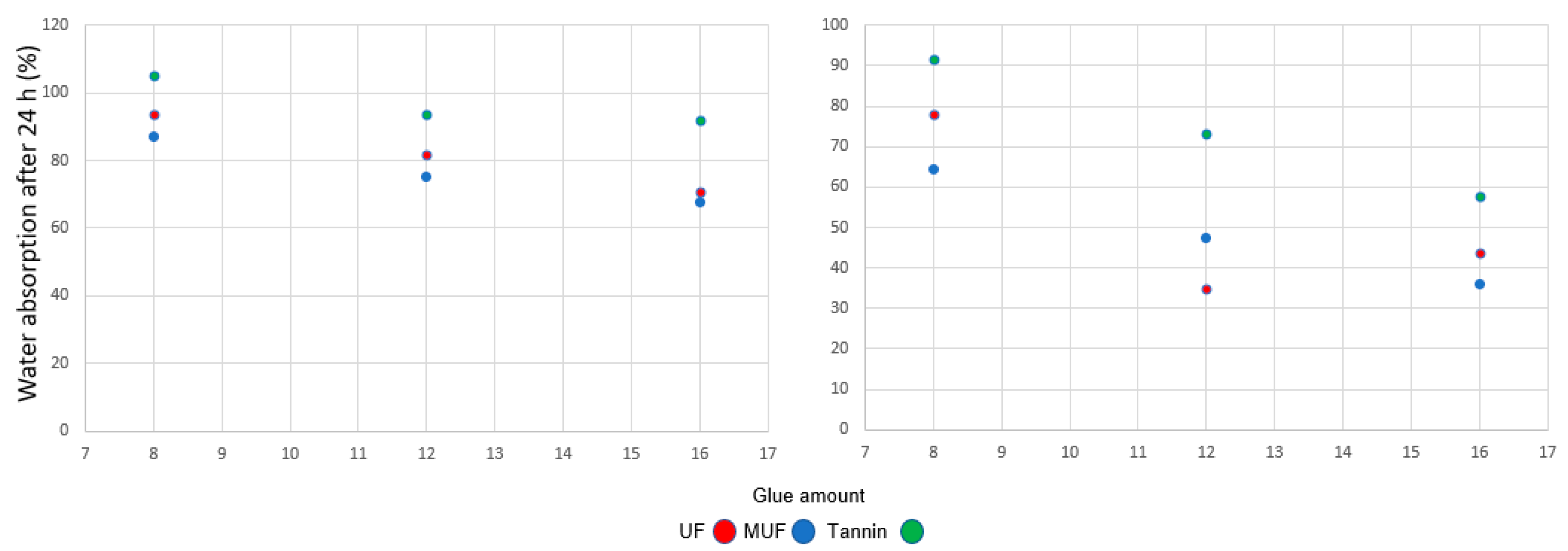Larch Bark as a Formaldehyde Scavenger in Thermal Insulation Panels
Abstract
1. Introduction
2. Materials and Methods
3. Results and Discussion
3.1. Free Formaldehyde Content and Formaldehyde Emission
3.2. Mechanical and Physical Properties of Larch Bark Insulating Panels
3.3. Moduli of Rupture and Elasticity
3.4. Internal Bond
3.5. Thickness Swelling and Water Absorption after 24 h
4. Conclusions
Author Contributions
Funding
Acknowledgments
Conflicts of Interest
References
- Wi, J.H.; Park, Y.U.; Kim, S. Evaluation of environmental impact on the formaldehyde emission and flame-retardant performance of thermal insulation materials. J. Hazard. Mater. 2020, 402, 123463. [Google Scholar] [CrossRef] [PubMed]
- Asdrubali, F.; D’Alessandro, F.; Schiavoni, S. A review of unconventional sustainable building insulation materials. Sustain. Mater. Technol. 2015, 4, 1–17. [Google Scholar] [CrossRef]
- Rudolphi, A.; Pfundstein, M. Insulating Materials: Principles, Materials, Applications; Walter De Gruyter: Basel, Switzerland, 2012; Available online: http://search.ebscohost.com/login.aspx?direct=true&scope=site&db=nlebk&db=nlabk&AN=642009 (accessed on 1 September 2020).
- Kalnæs, S.E.; Jelle, B.P. Vacuum insulation panel products: A state-of-the-art review and future research pathways. Appl. Energy. 2014, 116, 355–375. [Google Scholar] [CrossRef]
- Tsalagkas, D.; Börcsök, Z.; Pásztory, Z. Thermal, physical and mechanical properties of surface overlaid bark-based insulation panels. Eur. J. Wood Prod. 2019, 77, 721–730. [Google Scholar] [CrossRef]
- Hanson, J.L.; Kopp, K.B.; Yesiller, N.; Cooledge, C.M.; Klee, E. (Eds.) The Use of Recycled Materials as Thermal Insulation in Underground Construction; Humboldt State Univ.: Arcata, CA, USA, 2016. [Google Scholar]
- Bozsaky, D. Nature-Based Thermal Insulation Materials from Renewable Resources—A State-Of-The-Art Review. Slovak J. Civ. Eng. 2019, 27, 52–59. [Google Scholar] [CrossRef]
- Abdou, A.A.; Budaiwi, I.M. Comparison of Thermal Conductivity Measurements of Building Insulation Materials under Various Operating Temperatures. J. Build. Phys. 2005, 29, 171–184. [Google Scholar] [CrossRef]
- Naldzhiev, D.; Mumovic, D.; Strlic, M. Polyurethane insulation and household products—A systematic review of their impact on indoor environmental quality. Build. Environ. 2020, 169, 106559. [Google Scholar] [CrossRef]
- Klepeis, N.E.; Nelson, W.C.; Ott, W.R.; Robinson, J.P.; Tsang, A.M.; Switzer, P.; Behar, J.V.; Hern, S.C.; Engelmann, W.H. The National Human Activity Pattern Survey (NHAPS): A resource for assessing exposure to environmental pollutants. J. Expo. Anal. Environ. Epidemiol. 2001, 11, 231–252. [Google Scholar] [CrossRef]
- WHO. WHO Guidelines for Indoor Air Quality: Selected Pollutants; World Health Organization: Geneva, Switzerland, 2010. Available online: https://apps.who.int/iris/handle/10665/260127 (accessed on 1 September 2020).
- Tudor, E.M.; Barbu, M.C.; Petutschnigg, A.; Réh, R.; Krišťák, Ľ. Analysis of Larch-Bark Capacity for Formaldehyde Removal in Wood Adhesives. Int. J. Environ. Res. Public Health 2020, 17, 764. [Google Scholar] [CrossRef]
- Medved, S.; Gajsek, U.; Tudor, E.M.; Barbu, M.C.; Antonovic, A. Efficiency of bark for reduction of formaldehyde emission from particleboards. Wood Res. 2019, 2019, 307–316. [Google Scholar]
- Jahanshaei, S.; Tabarsa, T.; Asghari, J. Eco-friendly tannin-phenol formaldehyde resin for producing wood composites. Pigment Resin Technol. 2012, 41, 296–301. [Google Scholar] [CrossRef]
- Chai, Y.; Zhao, Y.; Yan, N. Synthesis and Characterization of Biobased Melamine Formaldehyde Resins from Bark Extractives. Ind. Eng. Chem. Res. 2014, 53, 11228–11238. [Google Scholar] [CrossRef]
- Marbun, S.D.; Wahyudi, I.; Suryana, J.; Nawawi, D.S. Bonding strength of benuang and duabanga glulams using their barks as phenol formaldehyde-filler. Appl. Adhes. Sci. 2020, 8. [Google Scholar] [CrossRef]
- Chen, H.; Yan, N. Application of Western red cedar (Thuja plicata) tree bark as a functional filler in pMDI wood adhesives. Ind. Crop. Prod. 2018, 113, 1–9. [Google Scholar] [CrossRef]
- Réh, R.; Igaz, R.; Krišťák, Ľ.; Ružiak, I.; Gajtanska, M.; Božíková, M.; Kučerka, M. Functionality of Beech Bark in Adhesive Mixtures Used in Plywood and Its Effect on the Stability Associated with Material Systems. Materials 2019, 12, 1298. [Google Scholar] [CrossRef]
- Mirski, R.; Kawalerczyk, J.; Dziurka, D.; Wieruszewski, M.; Trocinski, A. Effects of using bark particles with various dimensions as a filler for urea-formaldehyde resin in plywood. BioResources 2020, 2020, 1692–1701. [Google Scholar]
- Aydin, I.; Demirkir, C.; Colak, S.; Colakoglu, G. Utilization of bark flours as additive in plywood manufacturing. Eur. J. Wood Prod. 2017, 75, 63–69. [Google Scholar] [CrossRef]
- Skrypnik, L.; Grigorev, N.; Michailov, D.; Antipina, M.; Danilova, M.; Pungin, A. Comparative study on radical scavenging activity and phenolic compounds content in water bark extracts of alder (Alnus glutinosa (L.) Gaertn.), oak (Quercus robur L.) and pine (Pinus sylvestris L.). Eur. J. Wood Prod. 2019, 77, 879–890. [Google Scholar] [CrossRef]
- Kain, G.; Güttler, V.; Barbu, M.-C.; Petutschnigg, A.; Richter, K.; Tondi, G. Density related properties of bark insulation boards bonded with tannin hexamine resin. Eur. J. Wood Prod. 2014, 72, 417–424. [Google Scholar] [CrossRef]
- Petutschnigg, A.; Barbu, M.C.; Tudor, E.M.; Berger, G.; Tondi, G.; Kain, G. Neue Baumaterialien für nachhaltige Konstruktionen. Österreichische Ing. Archit. Z. 2017, 2017, 159–163. [Google Scholar]
- Zhu, H.; Lu, Z.; Li, X.; Zhang, J.; Yuan, M. Analysis on test methods for determining formaldehyde emission from wood-based products. China Wood Ind. 2009, 2009, 37–40. [Google Scholar]
- Zhang, J.; Song, F.; Tao, J.; Zhang, Z.; Shi, S.Q. Research Progress on Formaldehyde Emission of Wood-Based Panel. Int. J. Polym. Sci. 2018, 2018, 1–8. [Google Scholar] [CrossRef]
- Kain, G.; Stratev, D.; Tudor, E.M.; Lienbacher, B.; Weigl, M.; Barbu, M.C.; Petutschnigg, A. Qualitative investigation on VOC-emissions from spruce (Picea abies) and larch (Larix decidua) loose bark and bark panels. Eur. J. Wood Prod. 2020, 78, 403–412. [Google Scholar] [CrossRef]
- Kain, G.; Tudor, E.M.; Barbu, M.C. Bark Thermal Insulation Panels: An Explorative Study on the Effects of Bark Species. Polymers 2020, 12, 2140. [Google Scholar] [CrossRef]
- Wood-Based Panels—Determination of Formaldehyde Release—Part 5: Extraction Method (Called the Perforator Method); EN ISO 12460-5:2016; ISO: Geneva, Switzerland, 2016.
- Salthammer, T.; Mentese, S.; Marutzky, R. Formaldehyde in the indoor environment. Chem. Rev. 2010, 110, 2536–2572. [Google Scholar] [CrossRef]
- Wood-Based Panels—Sampling and Cutting of Test Pieces; ISO-16999:2003; European Committee for Standardization: Brussels, Belgium, 2003.
- Determination of the Emission of Formaldehyde from Building Boards—Desiccator Method; JIS A 1460:2015; European Committee for Standardization: Brussels, Belgium, 2015.
- Wood-Based Panels. Determination of Modulus of Elasticity in Bending and of Bending Strength; EN 310:1993; European Committee for Standardization: Brussels, Belgium, 1993.
- Particleboards and Fibreboards. Determination of Tensile Strength Perpendicular to the Plane of the Board; EN 319:1993; European Committee for Standardization: Brussels, Belgium, 1993.
- Particleboards and Fibreboards. Determination of Swelling in Thickness after Immersion in Water; EN 317:1993; European Committee for Standardization: Brussels, Belgium, 1993.
- Pizzi, A. Hot-setting tannin–urea–formaldehyde exterior wood adhesives. Adhes. Age 1977, 1977, 17–29. [Google Scholar]
- Cameron, F.A.; Pizzi, A. Tannin-induced formaldehyde release depression in urea-formaldehyde particleboard. In Formaldehyde Release from Wood Products; Chapter 15; Meyer, B., Kottes-Andrews, B.A., Reinardt, R.M., Eds.; American Chemical Society Symposium Series; ACS Publications: Washington, DC, USA, 1985; p. 205. [Google Scholar]
- Bianchi, S. Extraction and Characterization of Bark Tannins from Domestic Softwood Species. Ph.D. Thesis, Faculty of Mathematics, Informatics and Natural Sciences, Department of Biology, University of Hamburg, Hamburg, Germany, 2016. [Google Scholar]
- Pizzi, A. Types, processing and properties of bioadhesives for wood and fibers. In Advances in Biorefineries; Waldron, K., Ed.; Woodhead Publishing: Cambridge, UK, 2014. [Google Scholar]
- Wood-Based Panels for Use in Construction—Characteristics, Evaluation of Conformity and Marking; EN 13986:2015; European Committee for Standardization: Brussels, Belgium, 2015.
- Tudor, E.M.; Barbu, M.C.; Petutschnigg, A.; Réh, R. Added-value for wood bark as a coating layer for flooring tiles. J. Clean. Prod. 2018, 170, 1354–1360. [Google Scholar] [CrossRef]
- Sachsse, H.A. Eigenschaften und Verwertung des Lärchenholzes. Allg. Forstz. 1979, 1979, 118–122. [Google Scholar]







| Board | Density | Glue | Glue | Moisture |
|---|---|---|---|---|
| (kg/m3) | Type | Amount (%) | Content (%) | |
| UF1 | 500 | UF | 8 | 8.7 |
| UF2 | 500 | UF | 12 | 10.1 |
| UF3 | 500 | UF | 16 | 8.7 |
| UF4 | 300 | UF | 8 | 8.4 |
| UF5 | 300 | UF | 12 | 9.6 |
| UF6 | 300 | UF | 16 | 8.2 |
| MUF1 | 500 | MUF | 8 | 4.2 |
| MUF2 | 500 | MUF | 12 | 4.4 |
| MUF3 | 500 | MUF | 16 | 4.8 |
| MUF4 | 300 | MUF | 8 | 9.2 |
| MUF5 | 300 | MUF | 12 | 7.7 |
| MUF6 | 500 | MUF | 8 | 8.4 |
| T1 | 500 | Tannin | 12 | 5.8 |
| T2 | 500 | Tannin | 16 | 7.3 |
| T3 | 300 | Tannin | 8 | 9.9 |
| T4 | 300 | Tannin | 12 | 7.6 |
| T5 | 300 | Tannin | 16 | 8.4a |
| T6 | 300 | Tannin | 16 | 5.9 |
| Sample | MOR (N/mm2) | MOE (N/mm2) | IB (N/mm2) | TS 24 h (%) | WA 24 h (%) |
|---|---|---|---|---|---|
| 300UF8 | 0.29 (0.03) | 35.02 (3.62) | 0.07 (0.01) | 8.5 (0.81) | 93.71 (2.02) |
| 300UF12 | 0.33 0.04) | 57.15 (12.98) | 0.09 (0.02) | 6.54 (1.9) | 81.75 (1.2) |
| 300UF16 | 0.38 (0.02) | 50.22 (5.35) | 0.17 (0.04) | 5.21 (1.98) | 70.86 (0.56) |
| 500UF8 | 1.39 (0.17) | 283.18 (29.95) | 0.19 (0.02) | 14.64 (0.93) | 78.08 (1.68) |
| 500UF12 | 3.27 (0.53) | 556.78 (26.36) | 0.38 (0.04) | 8.42 (1.35) | 34.79 (3.31) |
| 500UF16 | 2.01 (0.09) | 403.05 (73.24) | 0.44 (0.03) | 7.18 (1.1) | 43.8 (7.29) |
| 300MUF8 | 0.19 (0.07) | 34.36 (2.15) | 0.08 (0.02) | 10.41 (1.71) | 87.09 (4.35) |
| 300MUF12 | 0.37 (0.02) | 63.16 (6.83) | 0.09 (0) | 8.72 (1.9) | 75.23 (3.43) |
| 300MUF16 | 0.38 (0.06) | 52 (5.92) | 0.15 (0.02) | 9.38 (3.04) | 67.55 (3.92) |
| 500MUF8 | 1.55 (0.01) | 278.16 (7.03) | 0.21 (0) | 13.36 (2.81) | 64.21 (3.96) |
| 500MUF12 | 2.33 (0.09) | 414.41 (13.68) | 0.32 (0.03) | 8.86 (1.24) | 47.48 (5.99) |
| 500MUF16 | 2.92 (0.61) | 511.28 (53.99) | 0.45 (0.06) | 7.51 (0.61) | 36.14 (4.89) |
| 300T8 | 0.05 (0.01) | 0 (0) | 0.07 (0.01) | 18.47 (2.34) | 105.3 (1.08) |
| 300T12 | 0.07 (0) | 0 (0) | 0.14 (0.01) | 10.79 (1.59) | 93.71 (2.23) |
| 300T16 | 0.05 (0) | 0 (0) | 0.14 (0.01) | 11.85 (1.75) | 91.81 (0.91) |
| 500T8 | 0.94 (0.07) | 187.72 (16.32) | 0.18 (0.01) | 25.89 (1.74) | 91.53 (2.16) |
| 500T12 | 1.87 (0.09) | 363.59 (11.05) | 0.32 (0.03) | 15.59 (1.42) | 73.41 (6.16) |
| 500T16 | 2.24 (0.39) | 432.26 (41.71) | 0.43 (0.01) | 13.06 (1.34) | 57.86 (8.84) |
Publisher’s Note: MDPI stays neutral with regard to jurisdictional claims in published maps and institutional affiliations. |
© 2020 by the authors. Licensee MDPI, Basel, Switzerland. This article is an open access article distributed under the terms and conditions of the Creative Commons Attribution (CC BY) license (http://creativecommons.org/licenses/by/4.0/).
Share and Cite
Barbu, M.C.; Lohninger, Y.; Hofmann, S.; Kain, G.; Petutschnigg, A.; Tudor, E.M. Larch Bark as a Formaldehyde Scavenger in Thermal Insulation Panels. Polymers 2020, 12, 2632. https://doi.org/10.3390/polym12112632
Barbu MC, Lohninger Y, Hofmann S, Kain G, Petutschnigg A, Tudor EM. Larch Bark as a Formaldehyde Scavenger in Thermal Insulation Panels. Polymers. 2020; 12(11):2632. https://doi.org/10.3390/polym12112632
Chicago/Turabian StyleBarbu, Marius Cătălin, Yasmin Lohninger, Simon Hofmann, Günther Kain, Alexander Petutschnigg, and Eugenia Mariana Tudor. 2020. "Larch Bark as a Formaldehyde Scavenger in Thermal Insulation Panels" Polymers 12, no. 11: 2632. https://doi.org/10.3390/polym12112632
APA StyleBarbu, M. C., Lohninger, Y., Hofmann, S., Kain, G., Petutschnigg, A., & Tudor, E. M. (2020). Larch Bark as a Formaldehyde Scavenger in Thermal Insulation Panels. Polymers, 12(11), 2632. https://doi.org/10.3390/polym12112632





